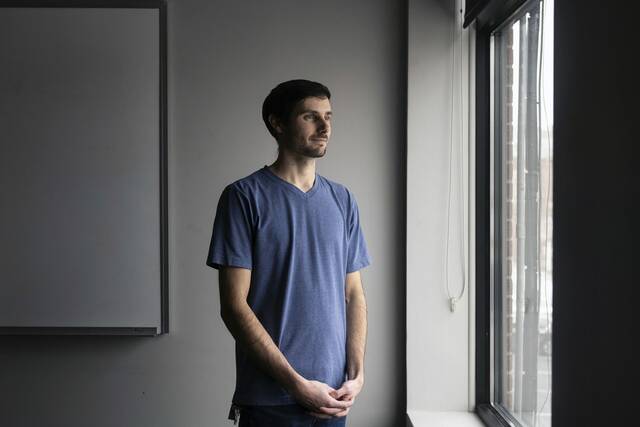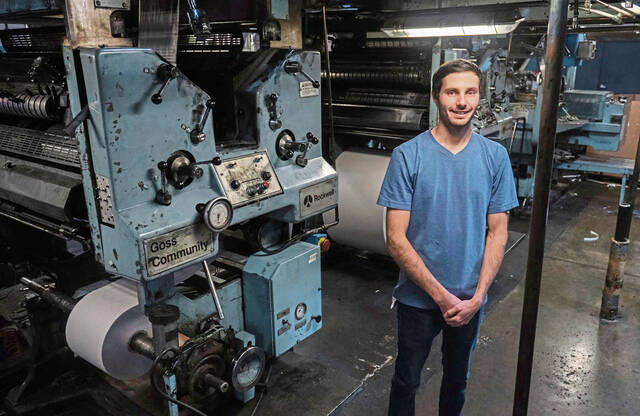Living with periodic paralysis: Ryan Csupak's fight for awareness on Rare Disease Day
In the past 15 years, Ryan Csupak has been in an emergency room 30 to 40 times, unable to move his legs and arms. He’s experienced shortness of breath, extreme fatigue and weakness.
This is the reality of having hyperkalemic periodic paralysis, a rare muscle disorder characterized by episodic attacks of muscle weakness associated with increased potassium levels. Episodes can range from mild weakness to paralysis, depending on the severity, and can last from minutes to hours.
People with this condition can end up in the hospital.
“Every day, I have some pain and weakness in my muscles,” said Csupak, 31, of Frazer, who was diagnosed in 2017. “It will be with me all my life. I have anxiety and sometimes can be depressed. It is scary.”
Periodic Paralysis has three common types: Hyperkalemic, Hypokalemic, and Andersen-Tawil syndrome.
It is being recognized on Rare Disease Day on Friday. Established in 2008 by EURORDIS — Rare Diseases Europe, the day was first observed in the U.S. in 2009, sponsored by the National Organization for Rare Disorders, a partner in the global campaign.
It’s a day to raise awareness about the impact of rare diseases on individuals and families, which are often overlooked in public health discussions.
“By designating a specific day, we sought to unite the global rare disease community — including patients, carers, health care professionals, researchers and policymakers — to advocate for better diagnosis, treatment and support systems,” said Stanislav Ostapenko, EURORDIS director of communication, via email.
Held on the last day of February, the inaugural Rare Disease Day was Feb. 29 because it is a rare date, occurring once every four years.
According to Orphanet, a resource for rare diseases, more than 6,000 distinct rare diseases have been identified.
Csupak first noticed something was wrong when he was 11 or 12 while taking a standardized test in school. After sitting for a time, he felt drained and his muscles tightened.
“It is hard to describe,” Csupak said. “It is like someone put Saran wrap around you and it keeps getting tighter and tighter. And as you try to stand up, a huge weight is pressing down on you. I felt so weak I fell to the floor.”
There is no cure, but a drug called Keveyis was approved in 2018 by the Federal Drug Administration.
Csupak said he has missed out on opportunities to hang out with his friends and participate in sports. He also said that, after having the covid-19 vaccines and covid in 2022, his symptoms became dramatically worse. Because of increased attacks, he is weaker and more fatigued.
He has had two episodes this week.
Having others to talk to helps, he said, such as Ralph Berthiaume of Springfield, Mass., founder of the Periodic Paralysis Support Network on Facebook, which has 3,400 members from 82 countries. Berthiaume, who was diagnosed with Hypokalemic Periodic Paralysis in 2001, said fewer than 6,000 people in the U.S. are affected by the disease.
“There are many times where doctors and even friends and family think people are faking, because they don’t understand the complexity of the disease, often because our muscle strength can vary from day to day,” Berthiaume said. “A lot of people think that periodic paralysis is just about paralysis. It’s not. Patients can have many other symptoms like muscle weakness, fatigue and pain.”
Csupak saw multiple doctors before finding one to help: Dr. Timothy Leichliter, director of movement disorders for Allegheny Health Network Neurology.
Leichliter said with periodic paralysis, there are occasions when, by the time a patient arrives at an emergency room, the episode has ended and they can move again. That can make it harder to diagnose.
With the help of Leichliter, and through genetic testing, Csupak, who paid for it out of pocket, was diagnosed with the SCN4A mutated gene in 2017. When he heard the diagnosis, he said he was shocked and relieved at the same time, because his symptoms weren’t in his head.
Caring for a periodic paralysis patient includes treating a person’s physical and mental health — as well as their entire family because it also can affect a patient’s loved ones, Leichliter said. Csupak said the support he has received from his wife, Brittany Miller-Csupak, has been wonderful, as has the help and understanding from his father, Doug Csupak.
During an episode, Csupak asked his wife to take a video. In it, he was clearly having trouble trying to stand. His arms were shaking.
“I talk to patients about being their own advocate and to never give up,” Leichliter said. “When you get a diagnosis, it validates you because, with a rare condition like this that most people have never heard of, it might make you feel alone.”
Csupak has felt alone, which is why he’s sharing his story.
“The awareness is so important,” said Csupak, a TribLive employee. “I fight every day to keep trying and doing my best. It takes a toll on you. It’s a struggle.
“I am trying to be an advocate because I don’t want anyone else to have to go through this.”
JoAnne Klimovich Harrop is a TribLive reporter covering the region's diverse culinary scene and unique homes. She writes features about interesting people. The Edward R. Murrow award-winning journalist began her career as a sports reporter. She has been with the Trib for 26 years and is the author of "A Daughter's Promise." She can be reached at jharrop@triblive.com.
Remove the ads from your TribLIVE reading experience but still support the journalists who create the content with TribLIVE Ad-Free.



